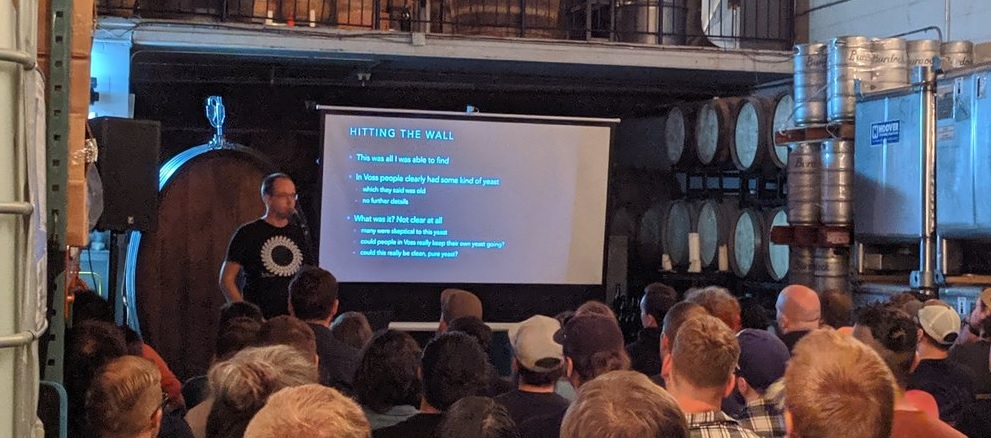
Ah, the last few days of summer… as long as we were are in the northern hemisphere. The neighborhood is literally humming with sound of critters, birds and bugs out gathering in the last of their winter’s stores. It’s actually quite the thing. Consider for a moment Keats’s Ode to Autumn, would you? My grapes are in that place between perfect ripeness and being mobbed by robins and blue jays. The chipmunks are invited. Few others are.
First up, Jordan and Robin interviewed the principals of the kveik roadshow driving through central Canada this week. Note: Lars says “kwehk” at the 8:10 mark of the audio but everyone else is saying “kvehk” so I really need this cleared up. I had to give up my own ticket to the event but it was put to good use as the photo above shows.
Speaking of beery gatherings, an interesting comment was made about the reaction to beers at a festival by one Florida brewer:
I make beer, have had this happen countless times, and completely disagree. Not everyone is going to like everything. And in a festival setting, etiquette often goes right out the window. I’d suggest removing ego from the equation, but then we wouldn’t have 7,500 breweries.
My thought was it was important to leave buckets and spittoons at fests as the dumping of the unwanted beer is always so common, either by the frenzied ticker or the simply disappointed.
The Chicago Tribune has reported on the hugely positively social media phenomenon #IAmCraftBeer that Dr. J thought to use to redirect a discussion that began with a very ugly start:
Chalonda White checked her phone Monday afternoon and saw a strange and jarring email. It was just three sentences and 35 words, sent to the address on her Afro Beer Chick website, where White, a Rogers Park resident, has blogged about her love of craft beer since 2017. It came from a name she’d never heard of — she suspects it was a pseudonym — laced with hate, misogyny and racism, including three uses of the N-word.
I might have just gone straight to “hate mail” and “Nazi” myself having seen Chalonda’s reaction on Twitter soon after she posted it. It was certainly good to see the hundred of positive reactions but also an important reminder that fascists find dirty corners to crawl into in every aspect of life. Good to make them uncomfortable anyway we can.
The Pursuit of Abbeyness has shared a welcome blog post on national parks in the British Peak District.
Given this longstanding industrial heritage, it is no surprise to find brewing prevalent in and around the Peaks. Burton-upon-Trent sits just 25km to the south, after all. Within the boundaries of the national park itself lie Thornbridge, Peak Ales, Taddington, Intrepid, Bradfield, Flash and the Wincle Beer Co. On its fringes there are a dozen or so more, including Abbeydale, Buxton and Torrside. And that is before we get to the thriving beer culture of Sheffield proper, or indeed Manchester.
 Did someone say England? The BBC Archives shared video of the 1948 English hop harvest last Friday.
Did someone say England? The BBC Archives shared video of the 1948 English hop harvest last Friday.
Furthermore and within that same decade, this series of photos commemorating the 75th anniversary of the liberation of Brussels when British troops arrived on the outskirts of the city in the evening of September 3, 1944 includes the image of Manneken Pis dressed as one of the liberating soldiers in full dress uniform.
The New Yorker magazine had an interesting article by Troy Patterson this week on natural wines which have always struck me as a partner to some of beer’s crueler styles. This snippet does not deter me from that suggestion:
One section featured the variety of skin-contact wines known as orange wines. One of these, from Friuli, glowed tropically in my candlelit glass. The list explained orange wine as a white wine that is made like a red; the skins and seeds, left to macerate in the juice for a while, impart color and texture. There was honey in the aroma. An intense whirligig of tannins metallically attacked my mouth and, on the finish, there was an astringent sizzle, with undertones of acid reflux. Tasting notes described this as a “long persistence.” I found it to be a test of stamina. While I waited for the wine’s acrid smack to wear off, I meditated on how this chic but peculiar elixir reflected the terroir of the urban social landscape.
Speaking of the cruelties of craft, Sophie Atherton has written in the UK’s Morning Advertiser about how craft has just gone too far:
What I see now is a hell of a lot of style over substance, with a glut of shoddy beers that appear to get away with it because they are on trend. The flip side is that more traditional beer is neglected, both in availability and keeping standards- which threatens to return us to the era of people viewing beer as a poor-quality drink.
This sort of succinct observation is one that you do not see made too often, given is it saying something bad in relation to brewing. Quite pleased to see it pop up in a major industry periodical.
This weeks winner of le dubbel extraordinaire is Jordan who also posted this week on his blog about his family’s very small hop farm or rather his failure to tend to his family’s very small hop farm:
The Centennial hops on Mom’s property in Kingston have been growing all summer. Some other year, I will go and watch them train up the trellis and coir, straining sunward at midday in their ascent. This year, it has been hard to find time, but it becomes obvious that for a good vinedresser, time is something to be made. You cannot learn physical skills by reading books. Even Stan Hieronymous’s excellent book on hops does not really tell you how you are to harvest them: 15 bines that do not quite express their full height and cluster together decoratively but not optimally for growth. 15 bines that now in the late summer take on the allium tinge of garlic where they have been sunburnt. 15 bines that I am a week late for.
On that story of the summer of 2019, Lew Bryson has founds some more excellent facts on White Claw: (i) one in three people will buy it again, (ii) seltzers are brewed, not formulated, (iii) nearly every liquor store and supermarket carries White Claw, only 20 percent of bars and restaurants are currently selling it, and (iv) he underestimated the tie-in with the keto diets. I still don’t think I am going to buy it. But my kids might. And, really, who cares?
There. Dusk at 7 pm now. Time’s a tickin’! I expect Boak and Bailey will have more news on Saturday and Stan should be there on Monday. The OCBG Podcast is a reliable break at work on Tuesdays, too. Except this week when it was on Wednesday. Go figure.









